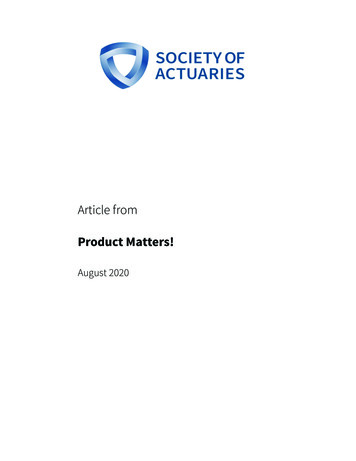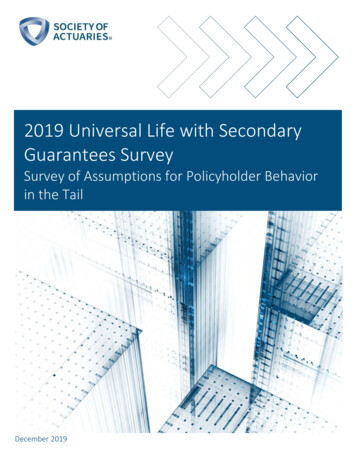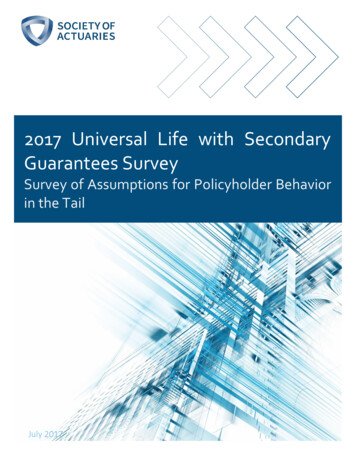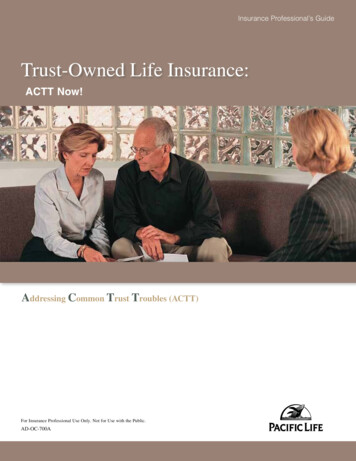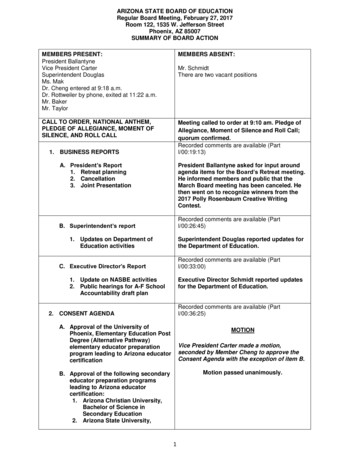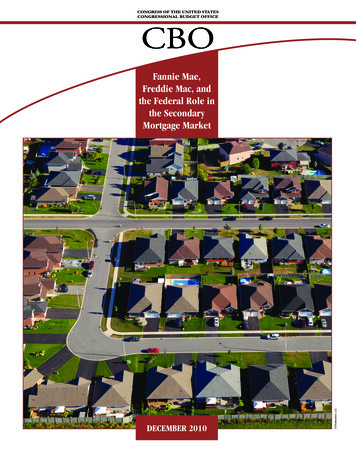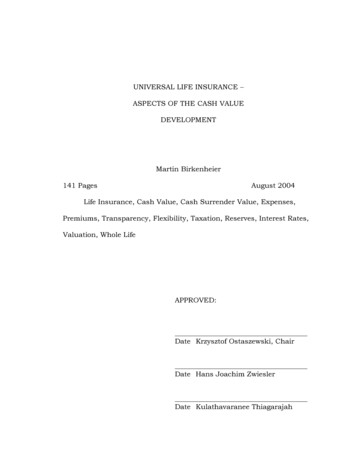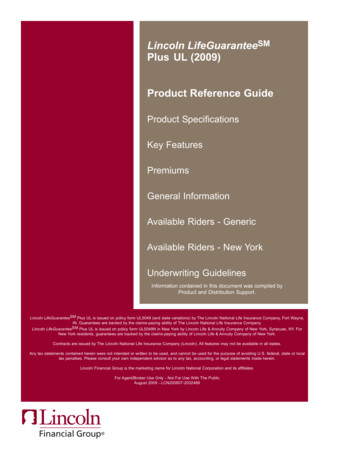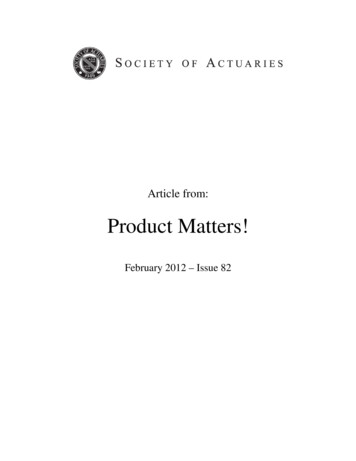
Transcription
Article from:Product Matters!February 2012 – Issue 82
Product DevelopmentSectionProduct!ISSUE 82 FEBRUARY 20121Universal Life WithSecondary Guarantees:Stochastic Pricing AnalysisBy Andrew Steenman andRob Stone3Chairperson’s CornerBy Donna Megregian8Retooling For Success InThe Post-Retirement MarketBy Steve Cooperstein10Product DevelopmentSection 2012 CouncilElectionsBy Christy Cook and PaulFedchak12SOA InternationalExperience Survey –Embedded Value FinancialAssumptionsBy Charles Carroll, WilliamHorbatt and DominiqueLebel22SOA Annual MeetingSummary – ProductDevelopment FocusBy Paula HodgesUniversal Life With Secondary Guarantees:Stochastic Pricing AnalysisBy Andrew Steenman and Rob StoneThis article is based on an excerpt from a Milliman Research Report on universal lifeinsurance with secondary guarantees (ULSG).Executive SummaryAs part of our research of ULSG products and designs we applied a set of stochastic scenarios as an example of the type of analysis that might be performed when pricing a newproduct. We observed that, even with a fair mix of up and down scenarios, statutory resultsand profit measures can be negatively skewed if the products are very sensitive to interestrate volatility. On a GAAP basis, it is cumbersome to review the typical ROE data from thestochastic output. It may be more effective to use point estimate ROE statistics or developalternative ways to review results.IntroductionStochastic profit analysis has become a more important aspect of the pricing process. Itcan be applied on both statutory and GAAP bases to analyze how profit measures wouldbe affected under adverse, optimistic, or random scenarios. An obvious practice wouldbe to explore interest rate scenarios, but a more intense approach could utilize alternativecombinations of lapse assumptions, mortality assumptions, premium payment patterns, andaccount value withdrawals. The opportunity exists to generate an exponentially larger stochastic set with each possible assumption and a massive amount of output data for analysis.The discussion in this article centers around samples of two common variants of ULSGs –level specified premium and single-fund shadow account designs. Our specified premiumCONTINUED ON PAGE 5
Universal Life With Secondary product was designed to offer a modest accumulationof account value over its lifetime. Our shadow accountdesign was created as a pure protection product withnegligible account value growth. For an additionaliteration we considered the impact of a hypotheticalsituation in which a company selling a ULSG productcould reinsure a portion of each policy, including thesecondary guarantee, to a captive. This arrangementwould use a letter of credit to back the statutory reservein excess of an economic reserve.For our analysis we selected a single pricing cell froma larger model office. The cell was male, standard nonsmoker at issue age 55 with a 1 million average faceamount. The pricing cell contained seven policies for 7 million of total face amount.Prior to presenting any results, it should be emphasizedthat work completed for the research report was basedon hypothetical product designs. The pricing resultswere not adjusted to produce particular return levelsbecause this research report was focused on typesof analysis and not the creation of the best design.Additionally, actual pricing exercises would include acomplete aggregation of business based on anticipateddemographics. The single cell chosen for this projectdoes not necessarily produce return levels that wouldbe expected from new product pricing in today’s market, but it is intended to be representative.Financial reporting basics for ULSGThe analysis was done in a financial reporting constructin accordance with our interpretation and experiencewith U.S. GAAP and statutory accounting principles,including the UL model regulation, Actuarial GuidelineXXXVIII, FAS97, and SOP 03-1. For the projection ofthe future SOP 03-1 reserve, we used a nested stochastic approach. Our application of these principles represents one of the possible approaches or interpretations.Profit measuresWe utilize two profit measures commonly applied toinsurance products—internal rate of return and returnon equity. The internal rate of return (IRR) is the interestrate at which the sum of the discounted future stream ofprofits is equal to zero. IRR provides a single statisticfrom page 1with which to evaluate the product, often by comparing it to a benchmark return. For this report we havedetermined IRR based on statutory distributable earnings(post-tax profits, after provision for required capital).The return on equity (ROE) is calculated as the aftertax GAAP profit in a period divided by an equity base.While IRR is a point statistic, the basic ROE calculations yield an array of values. The stream of ROE values can be used to analyze the profitability over time orcan be summarized into a single statistic using a rangeof methods. In practice we have found that the sum ofannual profits divided by the sum of equity bases anda discounted version of the same formula are commonROE point statistics. The discounted ROE statistic canbe used to incorporate a hurdle rate or cost of equityinto the calculation; we used an 8 percent discount rate.For our analysis, we examined the overall pattern ofROEs, but found found that these point statistics allowfor easier summary when comparing scenarios.Stochastic Profit AnalysisTo create a simplistic example of stochastic analysis,we applied a range of interest rate scenarios to oursample ULSG products. There could be much debateon the number, balance, and type of scenarios to usein this type of analysis, but we elected to use a set of50 scenarios based on the Dec. 31, 2010 yield curvefrom a generator provided by the American Academyof Actuaries. With these scenarios, an investmentportfolio of 10- and 20-year bonds was used so thatinterest rates progress somewhat smoothly. The bondswere assumed to be AAA- and A-rated with appropriate spreads included in the yield. Over the projectionperiod and across the 50 scenarios, the average annualreturn on investment was just above 5 percent. Thepattern of average returns is generally upward slopingand ranges from about 4.4 percent in the first investment year to about 6.5 percent in the final year of theprojection. We believe these scenarios represented areasonable range of variation and a reasonable longterm reversion point.ULSG Design: Specified premium The IRR from the stochastic projections are summarized in Figure (pg. 6, top, left). Note that thebase scenario IRR for this product was 7.2 percent.CONTINUED ON PAGE 6Product Matters! FEBRUARY 2012 5
Universal Life With Secondary from page 5Figure 1: ULSG Specified Premium DesignIRR From Stochastic Projections IRR RangeNumber of ScenariosIRR RangeNumber of ScenariosUndefined1Undefined40% to 1.99%10% to 1.99%112% to 3.99%102% to 3.99%164% to 5.99%184% to 5.99%126% to 7.99%146% to 7.99%38% to 9.99%38% to 9.99%310% and larger310% and larger1Average IRR5.50%Average IRR3.61% The chart in Figure 2 presents stochastic resultsfor the analysis of the GAAP profits. Note thatbase scenario point statistic ROEs for this productwere 6.4 percent using sums and 7.3 percent withdiscounting.Figure 2: ULSG Specified Premium DesignROE From Stochastic ProjectionsROE RangeNumber of ScenariosSum8%DiscountRateNegative100% to 1.99%32% to 3.99%4% to 5.99%FEBRUARY 2012 he chart in Figure 4 presents stochastic resultsTfor the analysis of the GAAP profits. Note thatbase scenario point statistic ROEs for this productwere 5.4 percent using sums and 4.6 percent withdiscountingFigure 4: ULSG Shadow Account DesignROE From Stochastic ProjectionsROE RangeNumber of ScenariosSum8%DiscountRateNegative41100% to 1.99%6181652% to 3.99%91016234% to 5.99%956% to 7.99%9156% to 7.99%628% to 9.99%348% to 9.99%7110% and larger2310% and larger93Average ROE4.83%6.20%Average ROE6.24%2.21%ULSG Design: Shadow account The IRR from the stochastic projections are summarized in Figure 3 (above, right). Note that thebase scenario IRR for this product was 5.1 percent.6 Figure 3: ULSG Shadow Account DesignIRR From Stochastic Projections Product Matters!In these tests almost all the results of the stochasticscenarios were skewed negatively, but a handful of scenarios had positive impacts on profitability. We foundthat this effect was only slightly attributable to scenariobias, because almost half of the scenarios showed anaverage investment return larger than the averagescenario. Our conclusion was that the volatility of theinvestment returns has a large impact on results. Theimpact of the investment volatility was visible primarily in the investment income lines of the statutory andGAAP income statements.
Additionally, the summed ROE point statistics for theshadow account product indicated a generally positiveeffect of the stochastic scenarios while the IRR and discounted ROE statistics showed mostly negative results.This occurred because both statutory and GAAP profitstended to be lower or negative in early years and higherand positive in later years.ULSG Design: Shadow account with financing solutionWe also applied the stochastic analysis to the shadowaccount product after creating a hypothetical financingsolution. On a statutory basis we found that the presentvalue of profits at sample discount rates increased foralmost every scenario. However, the shape of the general profit pattern changed in such a way that an IRRcould not be calculated for most scenarios. It turns outthat those scenarios had small positive IRRs and negative present values of profit without the financing solution, and even though the financing solution improvedthe profitability, the present value of profits remainednegative. On scenarios where the present value of profits was already positive, the IRRs were calculable andincreased compared to the results without financing.Analyzing the stochastic GAAP profit results for theproduct with a financing solution, we found that thepoint estimate ROEs tended to be negative or largebecause of negative sums of equity in the denominator for the sum statistics and small positive presentvalues of equity in the denominator for the discountedstatistics. This reduced the effectiveness of the pointestimates for summarizing the underlying profitability.Because our typical analysis didn’t provide muchinsight, we looked for alternative summaries of thedata. An interesting concept is to plot a data point foreach scenario with the sum of profits and equity as theFigure 5: Plot of GAAP Profit vs. EquitySum of GAAP Profit vs. EquitySum of ProfitsThe volatility of the investment returns also impactedthe projected credited rates on the base account value.In the cases where investment returns were poor, thesecondary guarantee in both designs kept the policy inforce despite the policy’s running out of account valuein earlier durations compared to higher return scenarios. However, we found that even in scenarios with generally above average returns, a few, intermittent yearsof poor investment returns could reduce profitability.Sum of Equitycoordinates. This allowed us to get some sense of howthe scenarios impacted results.We also considered a quadrant system to categorizeresults: Quadrant I contains scenarios with positive profitsand equity, which may be desirable if the ROE forthe scenario is sufficient. No scenarios fell into thisquadrant, and it is not shown on the chart above. Quadrant II contains scenarios with positive profitsand negative equity. These scenarios may be considered desirable outcomes. The scenarios in Quadrant III can be viewed as amix of good and bad results. The negative present value of equity means that the projected cellwould generate new equity that could be appliedelsewhere. For some scenarios the negative presentvalue of profits could represent a fair cost for thisequity. A company would have to decide where todraw the line on acceptable outcomes. Quadrant IV contains scenarios with negative profits and positive equity. These are the worst outcomes because they consume capital and do notgenerate a return. No scenarios fell into this quadrant, and it is not shown on the chart below.The chart in Figure 5 (above) plots the sums of equityand profits. The point marked as a square represents theresults from the base scenario.Andrew Steenman,ASA, MAAA, is anassociate actuarywith Milliman, Inc. Hecan be contacted at:Andrew.Steenman@milliman.comRob Stone, FSA,MAAA, is a consulting actuary withMilliman, Inc. He canbe contacted at: rob.stone@milliman.comProduct Matters! FEBRUARY 2012 7
Universal Life With Secondary Guarantees: Stochastic Pricing Analysis By Andrew Steenman and Rob Stone T his article is based on an excerpt from a Milliman Research Report on universal life insurance with secondary guarantees (ULSG). Executive Summary As part of our research of ULSG products and designs we applied a set of stochastic sce-
